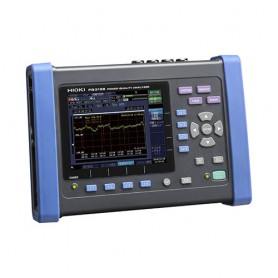



The Hioki PQ3198 Power Quality Analyzer is for monitoring and recording power supply anomalies, allowing their causes to be quickly investigated, and also for assessing power supply problems such as voltage drops, flicker, harmonics, and other electrical issues. New features include the ability to drive current sensors straight from the PQA and enhanced recording capabilities.
The critical importance of electrical power in today's society necessitates daily maintenance and management to ensure that problems don't occur. When they do, for example due to an equipment failure or abrupt surge in demand, engineers face the need to analyze the cause quickly. The PQ3198 provides robust support for field personnel who need to analyze power characteristics in the form of measurement capabilities that reliably captures the full range of power anomalies and exceptional ease of use throughout the entire user experience, from connecting the instrument to recording data.
Capture the full range of power supply anomalies, including momentary interruptions, voltage drops, and frequency fluctuations, while recording trends to help investigate the causes of unexpected equipment malfunctions and sudden stoppages.
Record fluctuations in voltage, current, power, harmonics, and flicker when connecting a highly variable system such as a renewable energy source or EV charging station to the grid. Easily analyze the data with the included PQ ONE software.
Use AC/DC auto-zero current sensors to measure DC current accurately over extended periods of time. Since the sensors are powered by the instrument, there is no need to set up a separate power supply.
The PQ3198 can measure all parameters at once, including power, harmonics, and anomaly waveforms.
When an event occurs, the instrument records the instantaneous waveform for 0.2 seconds. Triggers can be set for all event parameters in parallel, and you can check recorded data on the display while measurement is in progress.
When a voltage swell, dip, or inrush current event occurs, the PQ3198/PQ3100 can simultaneously record 1/2 RMS value fluctuations for 30 seconds.
The PQ3198 complies with the IEC 61000-4-30 Ed. 2 Class A standard. As a result, it can perform standard-mandated measurement tasks such as gapless, continuous calculation; detection of events such as swells, dips, and interruptions.
Part of the IEC 61000-4-30 international standard, Class A defines power quality parameters, accuracy, and standard compliance to facilitate the comparison and discussion of measurement results from different instruments.
The PQ3198 can measure transient voltages of up to 6000 V lasting as little as 0.5 μs (2 MS/s). It can also measure high-order harmonic components from 2 kHz to 80 kHz. As inverters enter into widespread use, malfunctions and failures in that frequency band are becoming more common.
Since the PQ3198's fourth voltage channel is isolated from its first three voltage channels, the instrument can measure power and efficiency across two separate circuits.
Since the PQ3198's fourth voltage channel is isolated from its first three voltage channels, the instrument can measure power and efficiency across two separate circuits. For example, you can verify the quality of the input (AC) and output (DC) of an EV rapid charger while simultaneously measuring power and efficiency between input and output.
The PQ3198 can measure the secondary side of inverters with a fundamental frequency of 40 to 70 Hz and a carrier frequency of up to 20 kHz. It can also measure the efficiency of DC/3-phase inverters.
Since sensor power is supplied by the instrument, there's no need for an AC adapter when using AC/DC sensors or flexible sensors.
In addition to 50/60 Hz, the PQ3198 can measure a line frequency of 400 Hz.
Since you can switch the display to show all measurement parameters while measurement is underway, it's easy to check conditions.
Simply connect current sensors, touch "Sensor" on the screen, and the instrument will automatically detect sensor types and maximum current ranges.
Simply choose the preset that suits your application, and the instrument will automatically configure the recording parameters.
The GPS OPTION PW9005 (not included) can be used to correct the instrument's internal time to UTC standard time. This capability eliminates any time difference between instruments to allow analysis that preserves the simultaneity of phenomena measured with multiple instruments.
Group data from different measurement locations, times, and dates into folders and view them together.
Group together trend graphs for multiple data sets and output them as a report. This feature is useful when you wish to compare dates from a repeat recording run or data from multiple locations.
Display detailed measurement data, including event statistics, an event list, and event graphs. Simply choose the parameters you need to output to the report.
Display statistics about events by date or time. This feature makes it easy to discover anomalies that occur at particular times of day or on particular days of the week. In addition, you can perform ITIC (CBEMA) curve analyses (using tolerance curves), which are used by power quality management standards in the U.S.
Evaluate whether data complies with the EN 50160 standard by analyzing it and generating a judgment based on voltage fluctuations during the trend interval. You can also customize the judgment criteria and parameters.
Reference: EX16183019EE
Brand: Extech
Dual Input AC/DC Clamp Meter, 600VAC/DC, 400AAC/DC NCV Detector & IR w/Lim NIST
Reference: EX41623472EC
Brand: Extech
Portable Indoor Air Quality Meter Measures: CO2/Temp/Humidity/Dew Point/Wet Bulb
Reference: IN09484614IG
Brand: Instek
9 kHz - 3.25 GHz Spectrum Analyzer, with High Speed Test and Tracking Generator
Reference: EX19658723E4
Brand: Extech
Digital Sound Level Meter with RS232 & PC Interface

Power Quality Analyzer